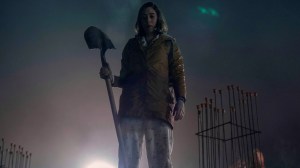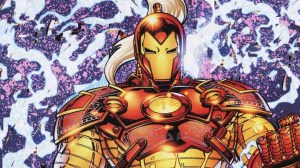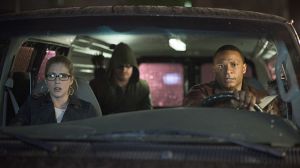Since Marvel Comics relaunched the Star Wars line, we’ve seen a lot of great stories. The core Star Wars title written by Jason Aaron has received consistent praise and been graced by a murderer’s row of modern artists including Stuart Immonen and John Cassaday.
Videos by ComicBook.com
The first volume of Darth Vader was a top pick from critics and the Doctor Aphra spinoff has launched a new character to much success. Star Wars is doing great and it’s hard to pick out which creators have done the best work with this beloved franchise.
With that having been said, we think the best comics creators to work on Star Wars at Marvel Comics so far is actually a dark horse pick.
It’s not a writer or artist, but a cartoonist who covers both sides of the field: Chris Eliopoulous.
Eliopoulous has done the vast majority of his work in mainstream comics as a letterer who has created a variety of fonts and contributed to more Mavel Comics publications than you can read on Unlimited*. He’s also a cartoonist who has taken to providing non-canonical takes on classic characters in a style reminiscent of Bill Watterson. He’s a great storyteller who values fun and clarity above all else.
And this is why we think he’s the best Star Wars artist working on the franchise today…
He Makes Pure Comics
One of the most difficult aspects of any comics franchise that is taken from another medium is trying to make it feel like it should be a comic. Anyone who has read an Aliens or Predators comic before knows exactly the kind of trouble this can cause. It’s easy to look at a comic based on a great film series and wonder why you would read this when you could have the “real thing” instead.
The Star Wars comics have done an excellent job of being enjoyable comics in their own right, but none have done it better than Eliopoulous’ stories with Jordie Bellaire on colors. Each of the three narratives he has created so far has told a complete story focused on a famous droid from the franchise. Everything you need is on the page and every comedic or dramatic beat is clear within his storytelling.
Nowhere is this more obvious than “Probe Droid Problem”, a story about one of Darth Maul’s spherical droids wandering Tatooine. Its silence is mirrored by all of the other characters in the book like Jawas and other droids. The entire story is conveyed in images with an occasional sound effect. Over the course of just a few pages Eliopoulous invests readers in this minor droid’s adventures and builds to a satisfactory ending with some laughs and a few surprise. The story is a great example of how much comics can accomplish in very little space, and how you really only need art in order to tell a story. For this reason alone Eliopoulous’ work stands out as being the best example of Star Wars comics today.

He Captures the Characters
Another issue with the translation of familiar film franchises to comics is the uncanny valley in which recognizable characters or elements are portrayed almost exactly as they are in real life, but in too dissimilar a manner to provide a comfortable experience. It is a pitfall avoided by most issues of Star Wars, but a handful of examples have seen semblances of Harrison Ford or Carrie Fischer appear more like wax sculptures than artistic constructs of their characters. That is an issue avoided altogether in Eliopoulous’ comics where he moves as far away from realism as possible.
Rather than attempt to depict Luke Skywalker exactly as Mark Hamill portrayed him in the first film, Eliopoulous distills the character into his most essential elements. Tousled farm boy hair, an earnest smile, and flight suit make it clear exactly who is in the pages of “Droid Dilemma”. It’s even easier to see with the three droids who form the centerpieces of these stories. You can count the lines that form each of them and easily imagine how you could ape Eliopoulous’ style to recreate them on a notepad at work. It’s here that the value of his cartooning is clear. These comics easily discern what makes each design resonate and recreates them in the simplest form possible. That makes for an easy reading experience and one unhindered by attempts to look just like the movies.

He Gets Star Wars
Ultimately the most important part of any Star Wars comic comes in capturing the essence of Star Wars. That’s an incredibly difficult task as the idea of what Star Wars is really about is something geeks have argued for decades. Eliopoulous appears to really get it though. His stories are not filled with epic quests, great prophecies, or massive space battles. These are all signatures of Star Wars, but they aren’t what make this collection of stories really matter. What Eliopoulous has chosen to focus on is the heart found within each of the heroes, and the humor and adventure that follows when characters do their best to battle for the light.
Each of the three stories told by Eliopoulous and Bellaire so far feature a droid attempting to help someone else. They find friendship, service, and love along the way, and those are themes it’s easy to perceive within the Star Wars films. While the story of “SaBBotage” might be minimized as a cute love story in which BB-8 helps two Resistance pilots go on a date, it’s really the same sort of meet-cute that made fans fall in love with Leia and Han. Star Wars has always been about the human elements within the grandiose space opera. There’s a reason we think of characters before any particular battle or special effect.
That’s what makes Eliopoulous’ work stand out most. He gets that Star Wars is fun and that it encourages us to believe in stories where the good guys win. It may not be complex, but the beauty of Star Wars often comes from its simplicity. That’s why Eliopoulous is the best Star Wars artist working today.
So be sure to check out Eliopoulous and Bellaire’s work in Star Wars: Droids Unplugged #1. It’s filled with the best Star Wars comics in the galaxy today.









